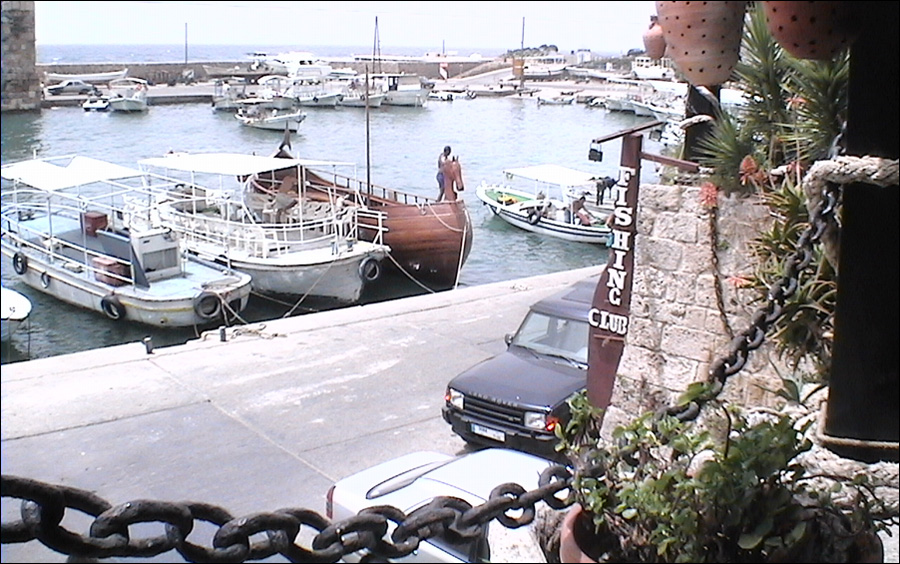
The ancient skill of building Phoenician ships is not a lost art . . . in fact it is still in use today. Historian Sanford Holst documented this remarkable experience in Lebanon:
“When I was in Tyre in 2004, the local boatmaster was just finishing one-and-a-half years of work constructing a ship by hand using the old Phoenician methods described below. It was an absolutely beautiful vessel, and he took the time to tell me about many of the details that went into it. The maiden voyage was to be two days later.
On the second day, I was having lunch at the harbor in Byblos — about 70 miles (115 km) north of Tyre — and quite incredibly the Phoenician ship sailed directly into the harbor and docked right in front of my table! The crew was as surprised as I was. We happily celebrated their successful voyage.”
— Image above —
Phoenician ship being built in Tyre by hand … almost finished.
— Image below —
Phoenician ship arriving in Byblos on its maiden voyage.

Phoenician boats have always been a source of astonishment to the many people who believe history is just one long upward sweep from the primitive past to the cultured present. In fact, it is more a matter of ups and downs, with the present (hopefully) being higher than the past. This was dramatically illustrated by the Dark Ages which followed the fall of the Roman Empire. Before that time, ancient ships were quite spectacular.
The rise of the Phoenicians’ shipbuilding and sea trade from meager fisherman roots to opulent cargoes of gold, jewels and royal-purple cloth is explored in Chapters 2 through 19 of Phoenicians: Lebanon’s Epic Heritage. Shipbuilding and sea trade are woven throughout the Phoenicians’ long history due to their vital importance in shaping and supporting early Lebanese society.
Phoenician Boat-building Secrets
An unfortunate hazard of sea trade is shipwrecks, but several of them turned out to be blessings in disguise — at least for us — because they preserved excellent examples of early ships and cargoes. And what a remarkable story they tell.
Consider the wreck at Uluburun, just off the coast of what is today called Turkey but back then was on the Byblos – Cyprus – Greece trade route. It showed us how these ships were laboriously and painstakingly built by skilled craftsmen. Each piece of wood in the hull was carved to create a row of “pockets” along the edge. On the piece of wood beside it, a similar row of pockets was carved, with each one being lined up exactly opposite a pocket in the neighboring board. A small piece of wood (tenon) was then put in each pocket (mortise) of one of the boards, which ended up looking like it had a long row of wooden teeth.

Then the second board was placed beside it and — with any luck at all — its own pockets fit perfectly onto the teeth of the other. Finally a round hole was drilled through each pocket-and-tooth, and a wooden peg was placed in the hole. When all the pegs were in place, the two boards could not be separated by any amount of force by wave or cargo. And this was done for virtually every board in the hull. Their craftsmanship was not only beautiful, it was incredibly strong. [Diagram and info are drawn from Appendix A: Art of Boatbuilding in Phoenicians: Lebanon’s Epic Heritage.]
Ocean-going Phoenician Ships
Nor were these tiny boats. The galley fighting-ships, with their rows of galley oars, could have a crew of over a hundred people. That is a pretty good size. But even those were small compared to the Phoenician cargo ships with their vast, rounded hulls. These ocean-going ships were built for huge loads and long hauls. They made the extended trips from Mediterranean ports out to Cadiz, Lixis and other destinations on the Atlantic Ocean coasts of Spain and Morocco, and had to make each trip count.
People have remarked that those cargo ships which sailed the seas for many hundreds of years B.C. were comparable in size to the ones Columbus sailed to America in 1492 A.D. Thor Heyerdahl, the modern-day explorer, noted that the Phoenicians could have sailed to Central America themselves. I don’t know if they did or not, but well-informed people see it as being within the capabilities of Phoenician ships and navigators. That is quite a compliment to these early people of the sea and what they were able to accomplish.
The content of this website is drawn from the research of historian Sanford Holst

Updated on January 16, 2024
CLOUD: Phoenician ships, Phoenician boats, sea trade, ancient ships, ship building, origin of Phoenicians

Further information
If you would like to experience more of the Phoenician world than you find in these short articles, see the book Phoenicians: Lebanon’s Epic Heritage. This extensive exploration is brightened with 104 illustrations.
Going beyond the few traditionally-cited facts, this authoritative work draws from discussions with leading archaeologists and historians to discover new clues and lines of inquiry into this secretive society.
Phoenicians
You can take a look inside this book. See the first pages here.
